Abstract
The clogging of porous and permeable pavements is a problem that faces many municipalities and, because of the high associated costs, it has become a major impediment to the uptake of such water sensitive and sustainable technologies. This study has experimentally examined the performance of seven cleaning methods that were shown to be able to restore higher infiltration rates in partially clogged pavement systems. It was found that high-pressure water injection was the most effective cleaning method, particularly when combined with vacuuming. The highest restoration of infiltration rate was achieved using high-pressure water injection combined with the highest-pressure vacuum, which produced an average increase in infiltration rate of 20.9%. Cleaning a porous pavement involves removing the sediment that has caused clogging in the first place. In normal circumstances, this collected sediment would have to be dried before disposal to a landfill, which is another costly process. Through a sustainability analysis, the potential reuse of collected sediment was investigated and it was found that the resulting economic and environmental benefit-cost ratios were high.
1. Introduction
1.1. Background
The infiltration of stormwater runoff is a key source control component of Water Sensitive Urban Design, Low Impact Development, Sustainable Drainage Systems [1,2] and the Chinese Sponge Cities Program [3]. Pervious concrete pavements enable stormwater runoff to infiltrate through their surface and during this process, pollutants are also retained. In contrast to impermeable asphalt and concrete pavements, pervious concrete pavements have a porous structure that not only promotes water infiltration but also allows evaporation of some of the infiltrated stormwater. Consequently, pervious concrete pavements contribute to improved flood control, water quality improvement and urban heat island amelioration [4].
There are two predominant types of pervious concrete pavement systems, namely ones that use porous concrete and ones that use permeable interlocking concrete pavers. Porous concrete systems permit stormwater infiltration through the open porous surface material. In contrast, permeable interlocking concrete pavers (PICPs) only allow stormwater to infiltrate through the openings or gaps between the pavers. Since the material from which PICPs are manufactured is impermeable, the concrete mix in PICPs is stronger and therefore porous concrete pavements tend to be thicker than an equivalent PICP block.
Previous studies on porous concrete, which is sometimes referred to as pervious concrete, have shown that the hydraulic conductivity is an important physical property that depends on the pore structure and particularly its tortuosity [5]. It has also been found that controlling the proportion of the constituent materials can play an important role in determining both the compressive strength and the permeability of porous concrete pavements [6]. Ultimately, porous concrete is still an economical balance of gravel, sand and cement and together with an adjusted water/cement ratio it can produce a material that provides environmental benefits without altering the basic function of the pavement [7].
However, both porous and permeable pavements are prone to gradual clogging over time by sediment and other pollutants conveyed in urban stormwater runoff. While there has been significant research into methods of measuring infiltration rates [8], such as the degree of clogging or the clogging process [9], there has been much less attention paid to restoring the infiltration capacity of clogged systems. Indeed, in a recent study, Nguyen et al. [10] concluded that the effects of clogging and quality maintenance programs should be assessed in more detail through further research.
Two previous investigations have examined the maintenance of porous concrete systems. The first of these focused on porous concrete specimens cored from field sites with the maintenance/rejuvenation methods being applied later in a laboratory [11]. Since the field sites covered a wide range of local conditions, the study did not focus on the sediment sizes or types that caused clogging of the porous concrete specimens. Instead, only sediment that was washed through the cored concrete specimens was collected and analyzed, which resulted in the collection of only a very small quantity of quite fine sediment. For example, an average of 43% of the collected sediment passed through a sieve with an opening size of 0.075 mm (ASTM No. 200) and it was only possible to conduct a single particle size analysis after combining all the clogged material ejected from several cored samples during the rejuvenation process. The second study on the maintenance of porous concrete only focused on low-strength, non-trafficable footpath systems [12], which have quite different material properties to the structural porous concrete used in the current study. In addition, Dougherty et al. [12] acknowledged that their study was pseudo-replicated because the test site results from a common segment of installed pavement were averaged to generate one value for porous concrete.
The few studies that have comprehensively investigated maintenance measures, such as pavement sweeping and vacuuming, have largely focused on permeable interlocking concrete pavers [13], polyurethane-bound granular material [14] or porous asphalt systems [15], rather than on porous concrete systems. In addition, none of the above previous investigations have explored the potential reuse of sediment collected during the cleaning process.
In terms of reusing fine sediment collected during the cleaning of porous concrete systems, it is important to understand how this may affect the physical properties of the concrete. Muthaiyan et al. [16] examined the effect on water permeability of adding 5%, 10% and 15% fine aggregate to porous concrete mixes that had cement contents of 200, 250 and 300 kg/m3. They found that adding 5% fines decreased permeability by approximately 18% and increasing the fines to 10% and 15% resulted in permeability reductions of approximately 25% and 30%, respectively. In the same study, Muthaiyan et al. [16] investigated the effect on water permeability of adding 10% and 20% fly ash to porous concrete mixes that had the same cement contents but this time with no fines added. This resulted in permeabilities decreasing by approximately 10% and 17%, respectively. Tang et al. [17] investigated the improved strength that could be gained by adding fine aggregate to porous concrete. They found that the fine aggregate content (5% and 10% of the coarse aggregate volume) was the most significant factor that contributed to the elastic modulus of the porous concrete. Moreover, the fine aggregate content was also the most significant factor in improving the splitting strength of the porous concrete. Li et al. [18] investigated how waste glass can be ground into a powder to replace part of the cement used to prepare porous concrete. They showed that water permeability decreased with an increasing proportion of added ground glass. However, the permeability decreased by less than 15% if the proportion of waste glass was less than 10%.
Based on the above-described previous research studies, the focus of this paper is to experimentally investigate the effect of seven pavement cleaning methods on the infiltration capacity of porous concrete systems. In addition, the potential for reusing sediment that is removed during the cleaning process is examined through a sustainability analysis.
1.2. Study Objectives
This experimental study aims to address the above-mentioned knowledge gaps by examining the effectiveness of seven different methods for cleaning porous concrete pavements. The seven cleaning methods investigated were a high-pressure water gun, three different strength vacuum devices, and combinations of the same high-pressure water gun with each of the three vacuum strengths. The cleaning effectiveness was measured as the ability to restore the porous concrete’s hydraulic conductivity. In addition, this study aims to investigate the benefits and costs associated with reusing sediment collected during the cleaning process.
2. Materials and Methods
2.1. Experimental Environment
All experiments were performed in the concrete engineering laboratories at the Xi’an University of Architecture and Technology, which is in the city of Xi’an in north-west China. All experimental tests were carried out at an indoor air temperature of 20 °C.
2.2. Concrete Materials
The porous concrete specimens used in the experiments were prepared according to the specifications of Chinese National Standard CJJ/T135–2009, as listed in Table 1. Each test specimen was 300 mm in diameter with a thickness of 100 mm (Figure 1).

Table 1.
Test specimen properties.
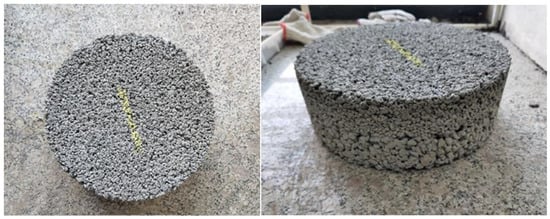
Figure 1.
Plan and elevation views of prepared test specimens.
2.3. Infiltration Experiments
Three identical porous concrete specimens were each tested at three percolation rates in the apparatus shown in Figure 2, which was adapted from [19]. The highest flowrate was set at 0.18 L/s, which corresponded to the material permeability of 0.255 cm/s. The other two flowrates were set at 0.13 L/s and 0.02 L/s to observe the infiltration temporal behavior of the porous concrete and in particular the time taken to reach steady state conditions. From the results of these initial infiltration tests, the middle flowrate (0.13 L/s) was selected for the remaining sediment tests.
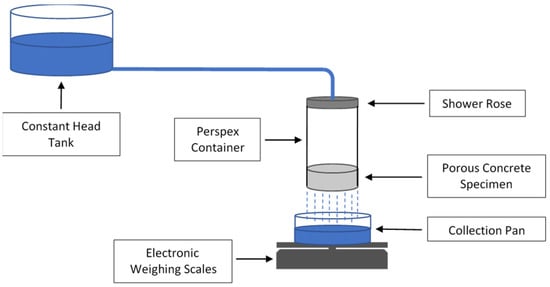
Figure 2.
Infiltration testing of porous concrete specimens.
To prevent water seepage around the edge of the specimen, its vertical sides were covered in plastic wrap before installation in the perspex container. The dry mass of the specimen was also recorded. Water was then distributed across the concrete specimens via a 300 mm diameter shower rose. The perspex container was sub-divided into an empty upper chamber, while the lower chamber contained the concrete specimen. This enabled the removal of the specimen while the flowrates were set. Once the flowrate was set and the specimen replaced, the time taken for water to penetrate through to the lower horizontal surface of the specimen was recorded. Electronic weighing scales (Model: ACS-HY-809B; Accuracy: ±5 g) recorded the mass of water seeping through the porous concrete specimens. At the completion of each test, the specimen was immediately removed and its wet mass recorded.
2.4. Sediment Properties
Sediment for the clogging experiments was prepared with the particle size distribution (PSD) shown in Figure 2. The test sediment was composed of quartz sands of various particle sizes and was developed to represent a typical PSD for the Xi’an region. The PSD for the quartz sand used in the preparation of the porous concrete samples is also included in Figure 2 for comparison.
2.5. Clogging Experiments
Eight permeable concrete specimens were prepared according to the material specifications in Table 1 and the sediment was prepared according to the particle size distribution in Figure 3. Each permeable concrete specimen was pre-washed with a high-pressure water gun to remove any existing loose sediment and other impurities in the specimen. Next, after allowing the test specimen to stand at room temperature for 48 h, the weight of the test piece was weighed every 1 h until the weight remained unchanged for three consecutive weighings to confirm that the specimen was in a dry state. The clean and dry specimens were then assembled in the apparatus shown in Figure 2. Each of the seven sediment quantities shown in Table 2 were evenly distributed and pressure-rolled onto one of the seven concrete specimens, as shown in Figure 4. The eighth specimen remained as a clean control. The infiltration experiment at the selected flowrate of 0.13 L/s was then repeated on each specimen.
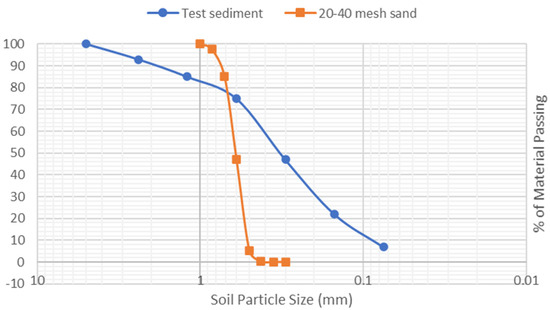
Figure 3.
Test sediment PSD.

Table 2.
Sediment application rates.
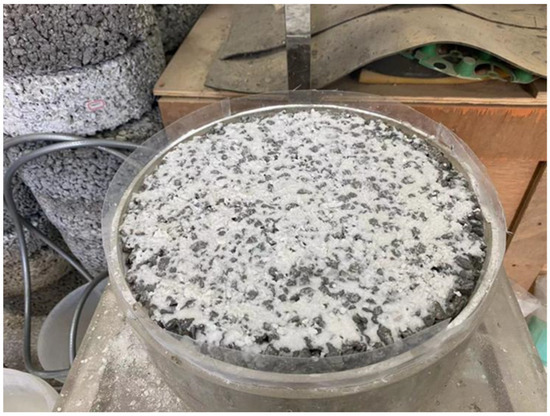
Figure 4.
Specimen with applied sediment.
The average infiltration rates through the eight specimens were then recorded for each of the seven sediment applications. This allowed the calculation of the amount of applied sediment required to cause the infiltration rate to decrease to the following levels: 85%, 75%, 65%, and 55% of the unclogged porous concrete specimens. These sediment levels were denoted as 15, 25, 35, and 45% clogging rates, respectively.
2.6. Cleaning Experiments
The following three cleaning devices were used in isolation and together to create seven combinations of cleaning procedure:
- A WS-3 high-pressure water gun with a peak pressure of 3500 kPa and a flowrate of 6 L/min.
- A high-power vacuum device with a motor power of 1200 W and a vacuum pressure of 17 kPa.
- A gear-adjustable vacuum device with two different gear motor powers of 700 W and 400 W, and corresponding vacuum pressures of 15 kPa and 10 kPa, respectively.
The seven selected cleaning combinations were: 1; 2; 3 (15 kPa); 3 (10 kPa); 1 + 2; 1 + 3 (15 kPa); and 1 + 3 (10 kPa).
To test the effectiveness of each cleaning procedure, a further 14 porous concrete specimens were prepared, pre-washed and dried according to the methods described in Section 2.2. For each of the seven cleaning methods, two specimens each had four applications of sediment corresponding to the four clogging rates, with cleaning occurring after each sediment application. After each round of cleaning, the infiltration rate was tested according to the method described in Section 2.3.
2.7. Sustainability Analysis
The sediment collected during the cleaning of partially clogged porous pavements is usually stockpiled off-site and dried before disposal. This is because the handling of wet materials is more expensive and requires sealed handling vehicles. Instead of disposal, the collected sediment could potentially be reused for a number of purposes. Three potential reuse options were initially considered before pursuing the most suitable option. The first was to reuse the collected sediment as bedding material below permeable interlocking concrete pavers. However, this option was discarded because firstly the sediment may contain pollutants that could later potentially leach to groundwater. A further reason was that the collected sediment sizes are likely to be much smaller than the desirable range of 2 to 7 mm, which commonly used to bed PICPs. The second reuse option that was considered was in the manufacturing of new porous concrete pavements in place of the fine virgin aggregates (sand) that are currently used. There are three reasons why this may not be feasible. The first is due to the difference in sediment size distributions, as shown in Figure 3, which would result in much of the collected sediment being rejected and probably re-directed to a landfill. The second reason is that only a small amount of fine aggregate, typically 5% to 10%, is used in the manufacture of porous concrete. The third reason is that the porous concrete market in Australia is still quite small.
Alternatively, the collected sediment could be reused in the manufacture of standard permeable interlocking concrete pavers (PICPs), the market for which is much larger. According to Knapton and Cook [20], global paver usage was 0·7 billion m2 per annum in the year 2000. At that time, Germany was the single largest market with more than 100 million m2 of pavers per annum. Other significant markets included 30 million m2 per annum in North America, 20 million m2 per annum in the UK, with most other developed countries achieving figures of the order of 10 million m2 per year. In addition, standard concrete pavers typically have a fine to coarse aggregate ratio of 50%, which is almost 10 times higher than for porous concrete. Therefore, the reuse of collected sediment for the manufacture of concrete block pavers was considered in this sustainability analysis, the details of which are summarised in Table 3.

Table 3.
Fine sediment reuse for the manufacturing of concrete block pavers.
In terms of sustainability, the benefit-cost ratio (BCR) of using recycled aggregate (RA) collected from the cleaning of porous concrete systems in place of virgin fine aggregates in the manufacturing of new PICPs was assessed by conducting a full life cycle analysis (LCA), using the method developed by Rahman et al. [21]. The life cycles of virgin aggregates (VA) and recycled sediments, including the costs associated with each stage of the process, the ensuing energy consumption as well as the CO2 emissions are shown in Figure 5. Virgin aggregates are assumed to be extracted from a quarry and then processed before use in the manufacture of porous concrete. The recycled sediments are collected from the cleaning of partially clogged porous pavement installations. The collected sediments are processed and graded in a recycling plant before use in the manufacture of porous concrete.

Figure 5.
LCA of virgin and recycled sediments and associated costs (adapted from Rahman et al. [21]).
Approximately 20% of the collected sediment is assumed to be non-recyclable and is deposited in a landfill. All material sent to the landfill is subject to a government levy in addition to processing costs. Other assumptions include a fixed rate of energy required for transporting aggregate or sediment from a quarry or an installation site to the manufacturing plant or to the landfill. A further assumption was that the same energy rate was needed for processing both virgin and recycled sediments at processing plants. In addition, the LCA model of Rahman et al. [21] includes cost and energy data collected from a number of quarry, recycling and landfill facilities around the world. However, in spite of these assumptions, the LCA is able to illustrate the potential economic and environmental benefits of recycling collected sediment for use in the manufacture of PICPs.
From the LCA, both the use and option values of resources were included in the calculation of a benefit-cost ratio (BCR) for replacing virgin aggregates with recycled sediments in the manufacture of PICPs. The use value represents the value derived from the physical use of a good and is the difference in cost between using recycled and virgin aggregates. The option value represents a potential source of benefit in the future through saved mining operations and land costs associated with not using virgin aggregates, as well as the saved landfill cost of the recycled materials. Consequently, the BCR represents the net benefit compared to the net cost associated with a given process. The potential reduction of CO2 emissions associated with using recycled aggregates was also included in the analysis as an environmental benefit.
3. Results and Discussion
3.1. Infiltration Testing
Figure 6 shows the results of infiltration testing on clean concrete specimens for the three selected flowrates.
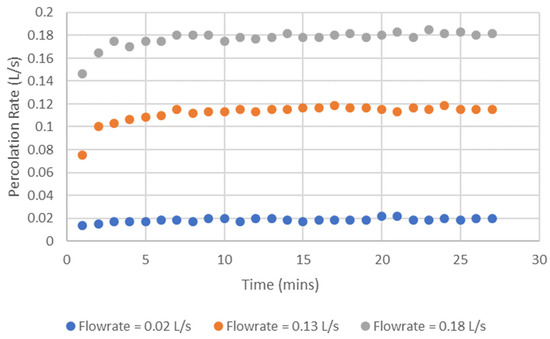
Figure 6.
Clean specimen percolation rates.
From these tests, it was decided to use the middle flowrate of 0.13 L/s for the clogging and cleaning experiments. This was because the highest flowrate of 0.18 L/s was at the maximum infiltration capacity of the concrete specimen, while the lowest flowrate of 0.02 L/s required almost one hour to reach steady state conditions.
3.2. Clogging Tests
The average infiltration rates for each of the seven sediment loads are shown in Figure 7.
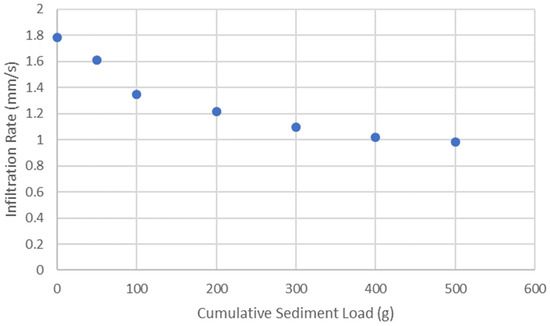
Figure 7.
Reduction in infiltration rate with applied sediment.
From Figure 7, the sediment loads required to reduce the infiltration rate by certain proportions can be derived, as shown in Table 4.

Table 4.
Sediment loads required for a given clogging rate.
3.3. Cleaning Tests
Figure 8 shows the average increase in infiltration rate that was measured for each of the seven cleaning methods.
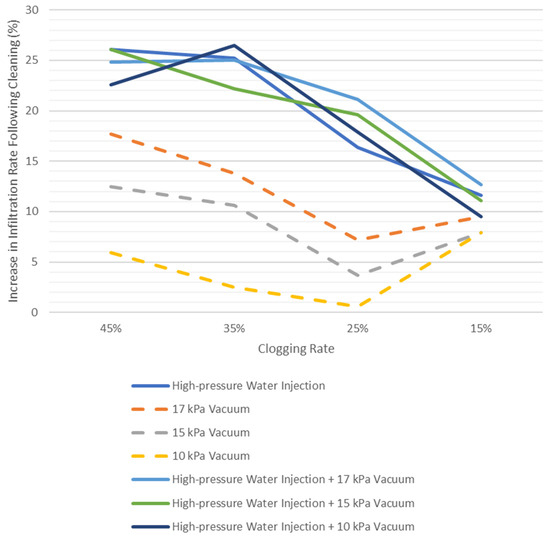
Figure 8.
Effectiveness of various cleaning methods.
From Figure 8, it is clear that the effectiveness of vacuum cleaning by itself increases with increasing vacuum pressure. In addition, vacuum cleaning by itself results in less effective cleaning than any of the four methods that used high-pressure water injection, although the differences are much less at lower clogging rates. It would appear that high-pressure water injection without vacuuming is almost as effective as adding a vacuum cleaning method. These results should encourage municipalities to consider adopting high-pressure water injection as a routine cleaning method for porous concrete systems, even though this method is generally more expensive than sweeping and vacuuming. To examine this more carefully, the average values for all clogging rates are presented in Table 5.

Table 5.
Average performance of various cleaning methods.
From Table 5, the best cleaning performance over the range of clogging rates was high-pressure water injection combined with the highest-pressure vacuum, which produced an average increase in infiltration rate of 20.9%. High-pressure water injection by itself displayed the third best performance, although in practical terms the increased cost of adding a vacuum cleaning method would have to be considered.
3.4. Reuse of Collected Sediment
Two porous concrete thickness (D = 100 mm and D = 200 mm) constructed using virgin aggregates were compared with four PICP thicknesses (60, 80, 100 and 150 mm), manufactured using fine sediment collected during pavement cleaning processes. The results in Table 6 show the net benefits for four paver types with different thicknesses that might be produced from using collected sediments as a fine aggregate component. This analysis shows that reusing collected sediment can potentially reduce greenhouse gas emissions by up to 359,000 kg of CO2 over the life of the pavement system.

Table 6.
Accounted benefits for using recycled aggregates in the pavement system (D = 100 mm) compared to using virgin aggregates (AUD = Australian dollars).
Compared to the cost of virgin materials, the lower visible cost (or use value) of reusing collected sediments generally provides benefits. As the market price of aggregates determines this benefit, there might be less or even no benefits if the price of recycled materials increases. The hidden cost (or option value) is also a key factor here, which is often not recognized but delivers an important cost to society. Visible costs are directly incurred costs while hidden costs are expenses that are not normally included in the purchase price for a resource. These include opportunity costs, such as a potential loss in profit from choosing one project over another, and intangible costs, such as the loss of community satisfaction from focusing additional resources on the project itself. The hidden benefits accounted for in this analysis were quite high and these generally controlled the overall benefit of the scenario. The results in Table 6 show that the hidden benefits increase even when the paver thickness increases. This is due to the increased benefit of not disposing of the collected sediments to a landfill.
Figure 9 shows the benefit-cost ratio (BCR) for the analyzed pavement systems, which were calculated as the ratio of accounted net benefits of using collected sediments against the cost of using them.
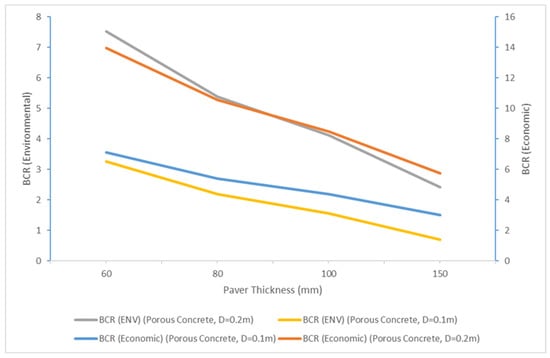
Figure 9.
Economic and environmental BCRs when using recycled aggregates in PICP compared to using virgin aggregates in porous concrete.
Figure 9 shows the economic and environmental BCRs associated with using recycled aggregates in the manufacture of four paver blocks (with thicknesses 60 to 150 mm) compared to using virgin aggregates used in the construction of two porous pavement thicknesses (100 mm and 200 mm). In Figure 9, both economic and environmental BCRs have a decreasing trend with increasing paver thickness. However, the rate of change in environmental BCR is higher than in the economic BCR, indicating the importance of using less materials in order to gain environmental benefits. This is possible with PICP because the concrete mix is stronger than that which was used in the construction of porous concrete.
4. Conclusions
The infiltration rate through the porous concrete specimens decreased with increasing levels of sediment blockage. It was found that some restoration of this infiltration rate was achieved with all seven types of cleaning process. For vacuum processes alone, the degree of cleaning increased with the vacuum pressure rate. However, none of the three vacuum cleaning methods alone achieved as high infiltration rate restoration as did the four methods that used a high-pressure water injection process, particularly at high clogging rates. The highest restoration of infiltration rate was achieved using high-pressure water injection combined with the highest-pressure vacuum, which produced an average increase in infiltration rate of 20.9%. However, this was only slightly more effective than high-pressure water injection by itself, which produced an average increase in infiltration rate of 19.7%.
Through a sustainability analysis, it was shown that for typical pavement thicknesses reusing sediment collected during cleaning processes can potentially reduce greenhouse gas emissions by up to 359,000 kg of CO2. The economic benefit cost ratios ranged from 3.01 to 13.97, while environmental benefit cost ratios ranged from 0.7 to 7.52. The hidden benefits increased when the paver thickness increased due to the increased benefit of not disposing of the collected sediments to a landfill.
A limitation of this experimental investigation was the manual application of sediment to the relatively small surface area of the specimen in the laboratory. It would be interesting, therefore, to replicate the clogging experiment at field-scale. In addition, the sustainability analysis required certain assumptions to be made for the life cycle assessment of sediments and aggregates. Therefore, further research would be useful in improving the assessment of the life cycle of the materials in order to increase the accuracy of the analysis.
Author Contributions
Conceptualization, Q.Y. and S.B.; methodology, Q.Y. and S.B.; validation, Z.G., S.B. and Q.Y.; formal analysis, Z.G.; investigation, Z.G.; resources, S.B. and Q.Y.; data curation, Z.G.; writing—original draft preparation, Z.G.; writing—review and editing, S.B. and Q.Y.; visualization, S.B. and Z.G.; supervision, Q.Y. and S.B.; project administration, Q.Y. All authors have read and agreed to the published version of the manuscript.
Funding
This research received no external funding.
Institutional Review Board Statement
Not applicable.
Informed Consent Statement
Not applicable.
Data Availability Statement
Not applicable.
Acknowledgments
The authors want to acknowledge Xi’an University of Architecture and Technology for academic and technical support towards this research.
Conflicts of Interest
The authors declare no conflict of interest.
References
- Matos, C.; Sá, A.B.; Bentes, I.; Pereira, S.; Bento, R. An approach to the implementation of Low Impact Development measures towards an EcoCampus classification. J. Environ. Manag. 2019, 232, 654–659. [Google Scholar] [CrossRef]
- Gimenez-Maranges, M.; Breuste, J.; Hof, A. Sustainable Drainage Systems for transitioning to sustainable urban flood management in the EuroUnion: A review. J. Clean. Prod. 2020, 255, 120191. [Google Scholar] [CrossRef]
- Qi, Y.; Chan, F.K.S.; Thorne, C.; O’Donnell, E.; Quagliolo, C.; Comino, E.; Pezzoli, A.; Li, L.; Griffiths, J.; Sang, Y.; et al. Addressing challenges of urban water management in Chinese sponge cities via nature-based solutions. Water 2020, 12, 2788. [Google Scholar] [CrossRef]
- Yang, Q.; Beecham, S.; Liu, J.; Pezzaniti, D. The influence of rainfall intensity and duration on sediment pathways and subsequent clogging in permeable pavements. J. Environ. Manag. 2019, 246, 730–736. [Google Scholar] [CrossRef]
- Kuang, X.; Sansalone, J.; Ying, G.; Ranieri, V. Pore-structure models of hydraulic conductivity for permeable pavement. J. Hydrol. 2011, 399, 148–157. [Google Scholar] [CrossRef]
- Lian, C.; Zhuge, Y.; Beecham, S. The relationship between porosity and strength for porous concrete. Constr. Build. Mater. 2011, 25, 4294–4298. [Google Scholar] [CrossRef]
- Sansalone, J.; Kuang, X.; Ranieri, V. Permeable pavement as a hydraulic and filtration interface for urban drainage. J. Irrig. Drain. 2008, 134, 666–674. [Google Scholar] [CrossRef]
- Winston, R.J.; Al-Rubaei, A.M.; Blecken, G.T.; Hunt, W.F. A simple infiltration test for determination of permeable pavement maintenance needs. J. Environ. Eng. 2016, 142, 06016005. [Google Scholar] [CrossRef]
- Razzaghmanesh, M.; Beecham, S. A review of permeable pavement clogging investigations and recommended maintenance regimes. Water 2018, 10, 337. [Google Scholar] [CrossRef]
- Nguyen, N.P.T.; Sultana, A.; Areerachakul, N.; Kandasamy, J. Evaluating the field performance of permeable concrete pavers. Water 2022, 14, 2143. [Google Scholar] [CrossRef]
- Chopra, M.; Kakuturu, S.; Ballock, C.; Spence, J.; Wanielista, M. Effect of rejuvenation methods on the infiltration rates of pervious concrete pavements. J. Hydrol. Eng. 2010, 15, 426–433. [Google Scholar] [CrossRef]
- Dougherty, M.; Hein, M.; Martina, C.A.; Ferguson, B.K. Quick surface infiltration test to assess maintenance needs on small pervious concrete sites. J. Irrig. Drain. Eng. 2011, 137, 553–563. [Google Scholar] [CrossRef]
- Simpson, I.M.; Winston, R.J.; Tirpak, R.A. Assessing maintenance techniques and in-situ pavement conditions to restore hydraulic function of permeable interlocking concrete pavements. J. Environ. Manag. 2021, 294, 112990. [Google Scholar] [CrossRef]
- Raeesi, R.; Xue, Y.; Disfani, M.M.; Arora, M. Hydrological and water quality performance of waste tire permeable pavements: Field monitoring and numerical analysis. J. Environ. Manag. 2022, 323, 116199. [Google Scholar] [CrossRef]
- Winston, R.J.; Al-Rubaei, A.M.; Blecken, G.T.; Viklander, M.; Hunt, W.F. Maintenance measures for preservation and recovery of permeable pavement surface infiltration rate—The effects of street sweeping, vacuum cleaning, high pressure washing, and milling. J. Environ. Eng. 2016, 169, 132–144. [Google Scholar] [CrossRef]
- Muthaiyan, U.M.; Thirumalai, S. Studies on the properties of pervious fly ash–cement concrete as a pavement material. Cogent Eng. 2017, 4, 1318802. [Google Scholar] [CrossRef]
- Tang, C.-W.; Cheng, C.-K.; Tsai, C.-Y. Mix design and mechanical properties of high-performance pervious concrete. Materials 2019, 12, 2577. [Google Scholar] [CrossRef]
- Li, A.; Qiao, H.; Li, Q.; Hakuzweyezu, T.; Chen, B. Study on the performance of pervious concrete mixed with waste glass powder. Constr. Build. Mater. 2021, 300, 123997. [Google Scholar] [CrossRef]
- Sounthararajah, D.P.; Loganathan, P.; Kandasamy, J.; Vigneswaran, S. Removing heavy metals using permeable pavement system with a titanate nano-fibrous adsorbent column as a post treatment. Chemosphere 2017, 168, 467–473. [Google Scholar] [CrossRef]
- Knapton, J.; Cook, I.D. Research and development in discrete element paving systems. Proc. Inst. Civ. Eng. Transp. 2002, 153, 13–23. [Google Scholar] [CrossRef]
- Rahman, M.M.; Beecham, S.; Iqbal, A.; Karim, M.R.; Rabbi, A.T.Z. Sustainability assessment of using recycled aggregates in concrete block pavements. Sustainability 2020, 12, 4313. [Google Scholar] [CrossRef]
Publisher’s Note: MDPI stays neutral with regard to jurisdictional claims in published maps and institutional affiliations. |
© 2022 by the authors. Licensee MDPI, Basel, Switzerland. This article is an open access article distributed under the terms and conditions of the Creative Commons Attribution (CC BY) license (https://creativecommons.org/licenses/by/4.0/).